Jessica Lin
GUM-SAGE: A Novel Dataset and Approach for Graded Entity Salience Prediction
Apr 15, 2025Abstract:Determining and ranking the most salient entities in a text is critical for user-facing systems, especially as users increasingly rely on models to interpret long documents they only partially read. Graded entity salience addresses this need by assigning entities scores that reflect their relative importance in a text. Existing approaches fall into two main categories: subjective judgments of salience, which allow for gradient scoring but lack consistency, and summarization-based methods, which define salience as mention-worthiness in a summary, promoting explainability but limiting outputs to binary labels (entities are either summary-worthy or not). In this paper, we introduce a novel approach for graded entity salience that combines the strengths of both approaches. Using an English dataset spanning 12 spoken and written genres, we collect 5 summaries per document and calculate each entity's salience score based on its presence across these summaries. Our approach shows stronger correlation with scores based on human summaries and alignments, and outperforms existing techniques, including LLMs. We release our data and code at https://github.com/jl908069/gum_sum_salience to support further research on graded salient entity extraction.
VSFormer: Value and Shape-Aware Transformer with Prior-Enhanced Self-Attention for Multivariate Time Series Classification
Dec 21, 2024Abstract:Multivariate time series classification is a crucial task in data mining, attracting growing research interest due to its broad applications. While many existing methods focus on discovering discriminative patterns in time series, real-world data does not always present such patterns, and sometimes raw numerical values can also serve as discriminative features. Additionally, the recent success of Transformer models has inspired many studies. However, when applying to time series classification, the self-attention mechanisms in Transformer models could introduce classification-irrelevant features, thereby compromising accuracy. To address these challenges, we propose a novel method, VSFormer, that incorporates both discriminative patterns (shape) and numerical information (value). In addition, we extract class-specific prior information derived from supervised information to enrich the positional encoding and provide classification-oriented self-attention learning, thereby enhancing its effectiveness. Extensive experiments on all 30 UEA archived datasets demonstrate the superior performance of our method compared to SOTA models. Through ablation studies, we demonstrate the effectiveness of the improved encoding layer and the proposed self-attention mechanism. Finally, We provide a case study on a real-world time series dataset without discriminative patterns to interpret our model.
Interactive Dialogue Agents via Reinforcement Learning on Hindsight Regenerations
Nov 07, 2024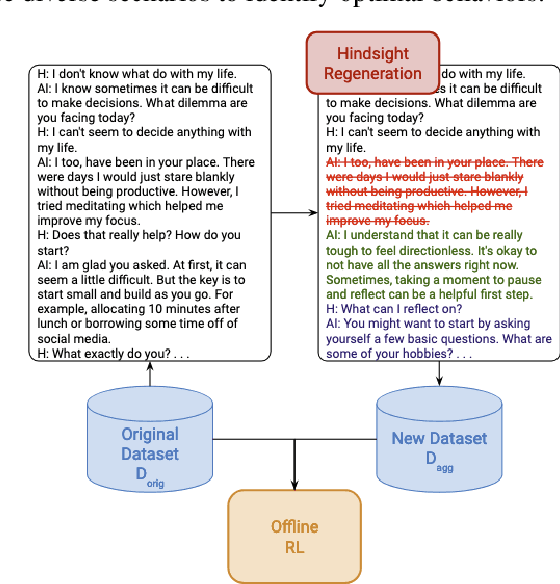

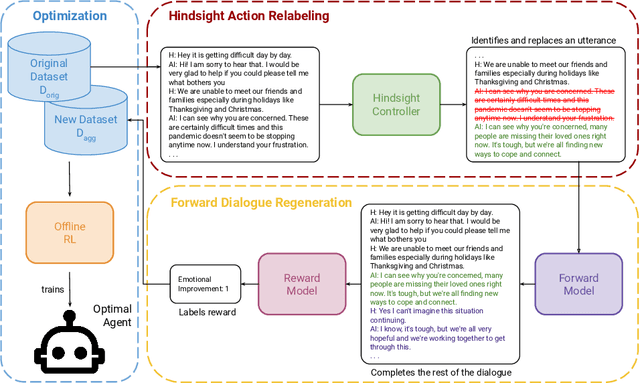

Abstract:Recent progress on large language models (LLMs) has enabled dialogue agents to generate highly naturalistic and plausible text. However, current LLM language generation focuses on responding accurately to questions and requests with a single effective response. In reality, many real dialogues are interactive, meaning an agent's utterances will influence their conversational partner, elicit information, or change their opinion. Accounting for how an agent can effectively steer a conversation is a crucial ability in many dialogue tasks, from healthcare to preference elicitation. Existing methods for fine-tuning dialogue agents to accomplish such tasks would rely on curating some amount of expert data. However, doing so often requires understanding the underlying cognitive processes of the conversational partner, which is a skill neither humans nor LLMs trained on human data can reliably do. Our key insight is that while LLMs may not be adept at identifying effective strategies for steering conversations a priori, or in the middle of an ongoing conversation, they can do so post-hoc, or in hindsight, after seeing how their conversational partner responds. We use this fact to rewrite and augment existing suboptimal data, and train via offline reinforcement learning (RL) an agent that outperforms both prompting and learning from unaltered human demonstrations. We apply our approach to two domains that require understanding human mental state, intelligent interaction, and persuasion: mental health support, and soliciting charitable donations. Our results in a user study with real humans show that our approach greatly outperforms existing state-of-the-art dialogue agents.
GDTB: Genre Diverse Data for English Shallow Discourse Parsing across Modalities, Text Types, and Domains
Nov 01, 2024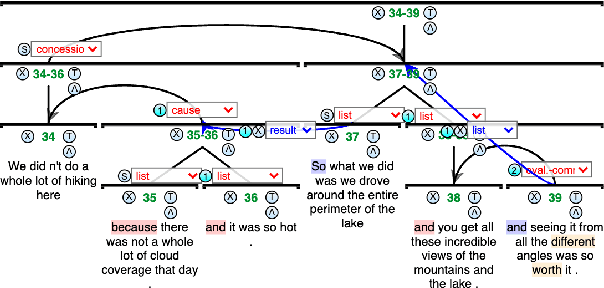
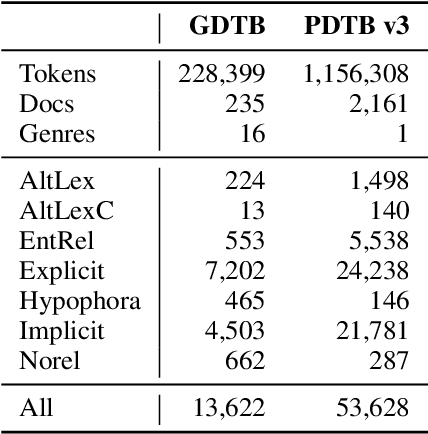
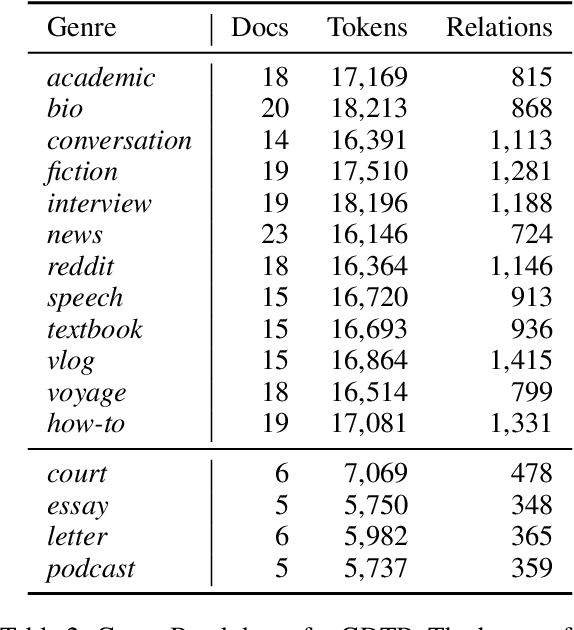
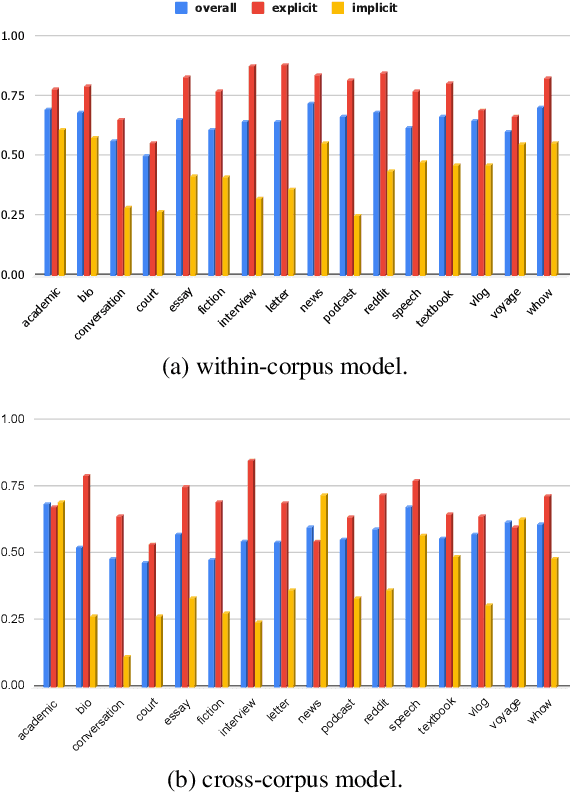
Abstract:Work on shallow discourse parsing in English has focused on the Wall Street Journal corpus, the only large-scale dataset for the language in the PDTB framework. However, the data is not openly available, is restricted to the news domain, and is by now 35 years old. In this paper, we present and evaluate a new open-access, multi-genre benchmark for PDTB-style shallow discourse parsing, based on the existing UD English GUM corpus, for which discourse relation annotations in other frameworks already exist. In a series of experiments on cross-domain relation classification, we show that while our dataset is compatible with PDTB, substantial out-of-domain degradation is observed, which can be alleviated by joint training on both datasets.
RandomNet: Clustering Time Series Using Untrained Deep Neural Networks
Aug 15, 2024Abstract:Neural networks are widely used in machine learning and data mining. Typically, these networks need to be trained, implying the adjustment of weights (parameters) within the network based on the input data. In this work, we propose a novel approach, RandomNet, that employs untrained deep neural networks to cluster time series. RandomNet uses different sets of random weights to extract diverse representations of time series and then ensembles the clustering relationships derived from these different representations to build the final clustering results. By extracting diverse representations, our model can effectively handle time series with different characteristics. Since all parameters are randomly generated, no training is required during the process. We provide a theoretical analysis of the effectiveness of the method. To validate its performance, we conduct extensive experiments on all of the 128 datasets in the well-known UCR time series archive and perform statistical analysis of the results. These datasets have different sizes, sequence lengths, and they are from diverse fields. The experimental results show that the proposed method is competitive compared with existing state-of-the-art methods.
GUMsley: Evaluating Entity Salience in Summarization for 12 English Genres
Jan 31, 2024Abstract:As NLP models become increasingly capable of understanding documents in terms of coherent entities rather than strings, obtaining the most salient entities for each document is not only an important end task in itself but also vital for Information Retrieval (IR) and other downstream applications such as controllable summarization. In this paper, we present and evaluate GUMsley, the first entity salience dataset covering all named and non-named salient entities for 12 genres of English text, aligned with entity types, Wikification links and full coreference resolution annotations. We promote a strict definition of salience using human summaries and demonstrate high inter-annotator agreement for salience based on whether a source entity is mentioned in the summary. Our evaluation shows poor performance by pre-trained SOTA summarization models and zero-shot LLM prompting in capturing salient entities in generated summaries. We also show that predicting or providing salient entities to several model architectures enhances performance and helps derive higher-quality summaries by alleviating the entity hallucination problem in existing abstractive summarization.
GENTLE: A Genre-Diverse Multilayer Challenge Set for English NLP and Linguistic Evaluation
Jun 03, 2023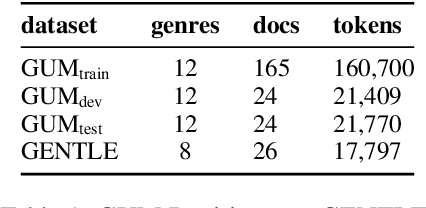
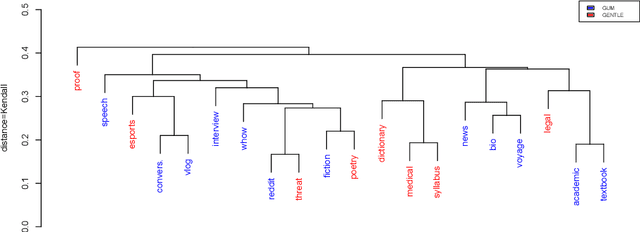
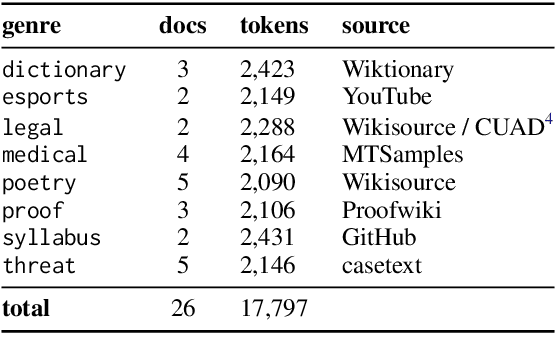
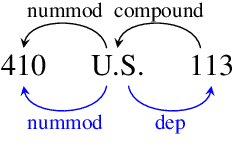
Abstract:We present GENTLE, a new mixed-genre English challenge corpus totaling 17K tokens and consisting of 8 unusual text types for out-of domain evaluation: dictionary entries, esports commentaries, legal documents, medical notes, poetry, mathematical proofs, syllabuses, and threat letters. GENTLE is manually annotated for a variety of popular NLP tasks, including syntactic dependency parsing, entity recognition, coreference resolution, and discourse parsing. We evaluate state-of-the-art NLP systems on GENTLE and find severe degradation for at least some genres in their performance on all tasks, which indicates GENTLE's utility as an evaluation dataset for NLP systems.
Deep RL at Scale: Sorting Waste in Office Buildings with a Fleet of Mobile Manipulators
May 05, 2023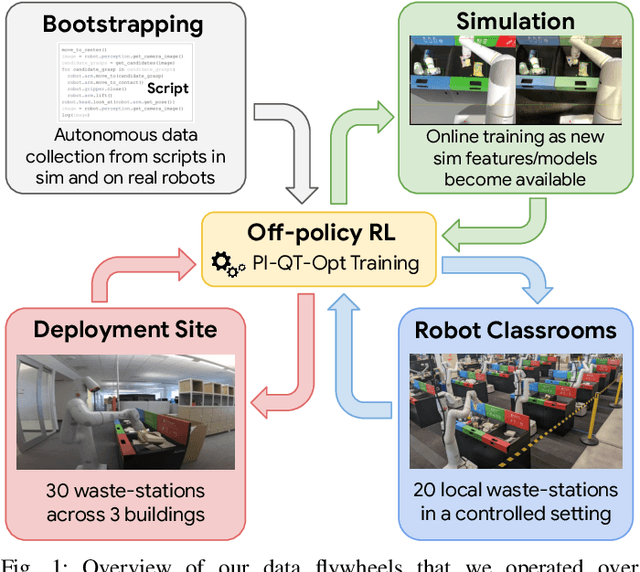
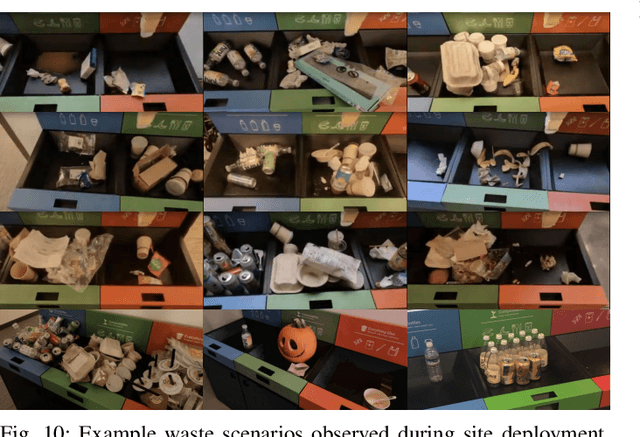
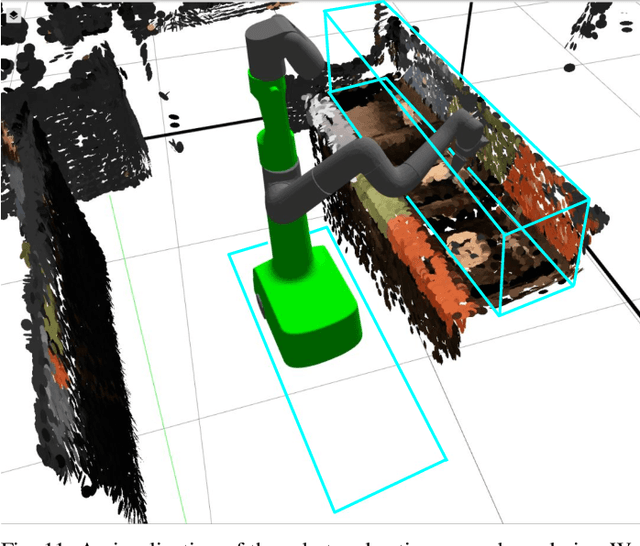
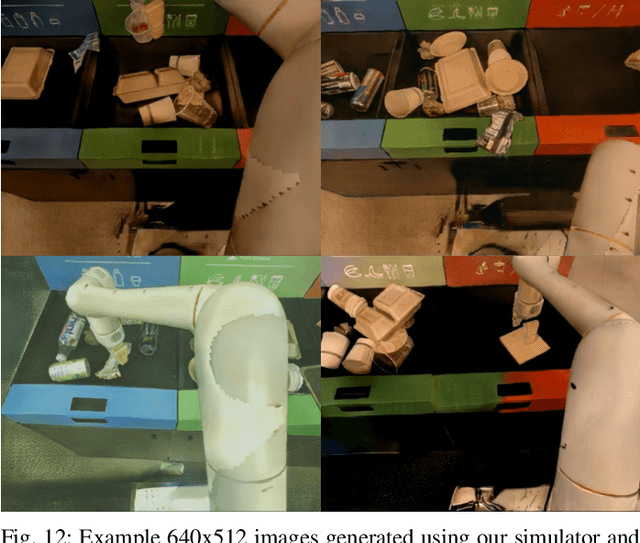
Abstract:We describe a system for deep reinforcement learning of robotic manipulation skills applied to a large-scale real-world task: sorting recyclables and trash in office buildings. Real-world deployment of deep RL policies requires not only effective training algorithms, but the ability to bootstrap real-world training and enable broad generalization. To this end, our system combines scalable deep RL from real-world data with bootstrapping from training in simulation, and incorporates auxiliary inputs from existing computer vision systems as a way to boost generalization to novel objects, while retaining the benefits of end-to-end training. We analyze the tradeoffs of different design decisions in our system, and present a large-scale empirical validation that includes training on real-world data gathered over the course of 24 months of experimentation, across a fleet of 23 robots in three office buildings, with a total training set of 9527 hours of robotic experience. Our final validation also consists of 4800 evaluation trials across 240 waste station configurations, in order to evaluate in detail the impact of the design decisions in our system, the scaling effects of including more real-world data, and the performance of the method on novel objects. The projects website and videos can be found at \href{http://rl-at-scale.github.io}{rl-at-scale.github.io}.
LB-SimTSC: An Efficient Similarity-Aware Graph Neural Network for Semi-Supervised Time Series Classification
Jan 17, 2023Abstract:Time series classification is an important data mining task that has received a lot of interest in the past two decades. Due to the label scarcity in practice, semi-supervised time series classification with only a few labeled samples has become popular. Recently, Similarity-aware Time Series Classification (SimTSC) is proposed to address this problem by using a graph neural network classification model on the graph generated from pairwise Dynamic Time Warping (DTW) distance of batch data. It shows excellent accuracy and outperforms state-of-the-art deep learning models in several few-label settings. However, since SimTSC relies on pairwise DTW distances, the quadratic complexity of DTW limits its usability to only reasonably sized datasets. To address this challenge, we propose a new efficient semi-supervised time series classification technique, LB-SimTSC, with a new graph construction module. Instead of using DTW, we propose to utilize a lower bound of DTW, LB_Keogh, to approximate the dissimilarity between instances in linear time, while retaining the relative proximity relationships one would have obtained via computing DTW. We construct the pairwise distance matrix using LB_Keogh and build a graph for the graph neural network. We apply this approach to the ten largest datasets from the well-known UCR time series classification archive. The results demonstrate that this approach can be up to 104x faster than SimTSC when constructing the graph on large datasets without significantly decreasing classification accuracy.
PMP: Privacy-Aware Matrix Profile against Sensitive Pattern Inference for Time Series
Jan 04, 2023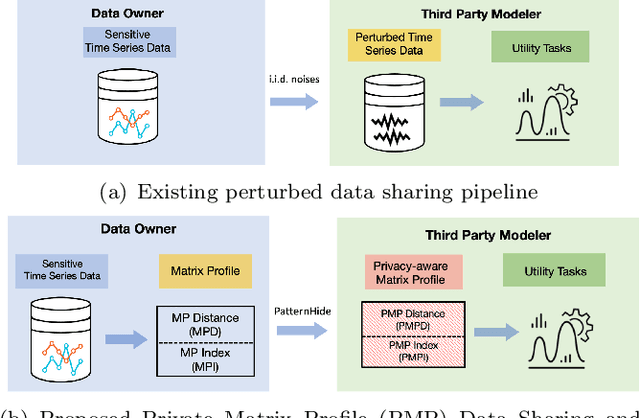


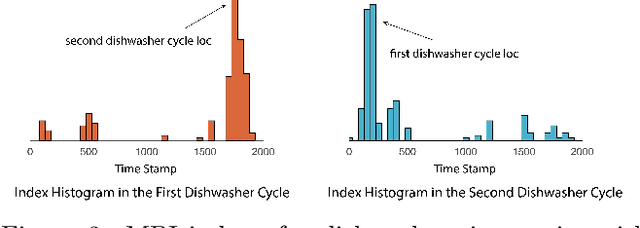
Abstract:Recent rapid development of sensor technology has allowed massive fine-grained time series (TS) data to be collected and set the foundation for the development of data-driven services and applications. During the process, data sharing is often involved to allow the third-party modelers to perform specific time series data mining (TSDM) tasks based on the need of data owner. The high resolution of TS brings new challenges in protecting privacy. While meaningful information in high-resolution TS shifts from concrete point values to local shape-based segments, numerous research have found that long shape-based patterns could contain more sensitive information and may potentially be extracted and misused by a malicious third party. However, the privacy issue for TS patterns is surprisingly seldom explored in privacy-preserving literature. In this work, we consider a new privacy-preserving problem: preventing malicious inference on long shape-based patterns while preserving short segment information for the utility task performance. To mitigate the challenge, we investigate an alternative approach by sharing Matrix Profile (MP), which is a non-linear transformation of original data and a versatile data structure that supports many data mining tasks. We found that while MP can prevent concrete shape leakage, the canonical correlation in MP index can still reveal the location of sensitive long pattern. Based on this observation, we design two attacks named Location Attack and Entropy Attack to extract the pattern location from MP. To further protect MP from these two attacks, we propose a Privacy-Aware Matrix Profile (PMP) via perturbing the local correlation and breaking the canonical correlation in MP index vector. We evaluate our proposed PMP against baseline noise-adding methods through quantitative analysis and real-world case studies to show the effectiveness of the proposed method.
 Add to Chrome
Add to Chrome Add to Firefox
Add to Firefox Add to Edge
Add to Edge